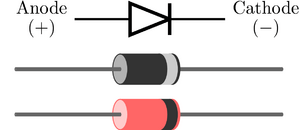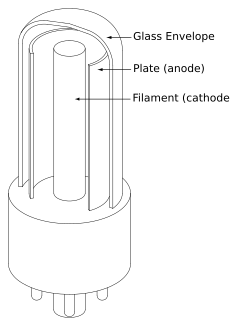Diode facts for kids
A diode is an electronic component that lets electricity flow through it in only one direction. Think of it like a one-way street for electric current. It has two connection points, called electrodes.
Diodes are very useful. They can change alternating current (AC), like the power from a wall socket, into direct current (DC), which most electronics use. This process is called rectification. Diodes are found in power supplies for many devices. They are also used in old-fashioned crystal radios to pick up radio signals. A special type of diode, called a LED, even produces light when electricity passes through it!
Most modern diodes are made from special materials called semiconductors, like silicon or germanium.
Contents
History of Diodes
The very first diodes were invented over a hundred years ago. They were called Fleming valves. These were big glass tubes, similar to old lightbulbs. Inside, they had a small heated wire and a larger metal plate. The heated wire would release electricity, which the plate would collect. Because only the wire was heated, electricity could only move in one direction through the tube.
Fleming valves are not used much today. They have been replaced by much smaller and more efficient semiconductor diodes. Interestingly, Thomas Edison also noticed this one-way electricity flow when he was working on his light bulbs.
How Diodes Are Made
Semiconductor diodes are made by joining two different types of semiconductor materials. Imagine one side has extra electrons, like a crowd of people with too many snacks. This is called the n-side (negative side). The other side has atoms that want electrons, like people who are hungry for snacks. This is the p-side (positive side).
Because of this setup, electricity flows easily from the n-side (with extra electrons) to the p-side (that wants electrons). But it's very hard for electricity to flow the other way. These special sides are created by adding tiny amounts of other chemicals to the silicon, a process called doping. For example, silicon with arsenic makes a good n-side, while silicon with aluminum makes a good p-side.
The connector attached to the n-side is called the cathode. The connector attached to the p-side is called the anode.
How a Diode Works
Electricity Flowing Forward
When you connect the positive side of a battery to the diode's p-side and the negative side to its n-side, the diode is in "forward bias." The electrons from the n-side are pulled towards the positive voltage on the p-side. At the same time, the "holes" (places where electrons are missing) from the p-side are pulled towards the negative voltage on the n-side. This allows electric current to flow through the diode.
However, a small amount of voltage is needed to get the current started. This is called the cut-in voltage. For a silicon diode, this is about 0.7 volts. For a germanium diode, it's about 0.3 volts.
Blocking Electricity Flow
If you reverse the battery, connecting the negative side to the p-side and the positive side to the n-side, the diode is in "reverse bias." Now, the electrons on the n-side are pulled away from the p-side, towards the positive battery terminal. The "holes" on the p-side are pulled away from the n-side, towards the negative battery terminal. This creates a gap, and current cannot flow easily between the two sides of the diode.
If you keep increasing the reverse voltage, eventually a point is reached where electricity will force its way through. This is called the breakdown voltage. Many diodes can be damaged or destroyed if too much reverse voltage is applied. However, some special diodes are designed to handle this reverse flow without breaking.
Temperature's Effect on Diodes
When a diode gets warmer, its cut-in voltage goes down. This means it becomes easier for electricity to pass through the diode in the forward direction.
Different Types of Diodes
There are many kinds of diodes, each designed for specific jobs. Some are for general use, while others have very specialized purposes.
Diode Symbols
Here are some common symbols you'll see for different diodes in circuit diagrams:
 |
 |
 |
 |
| Standard Diode | Zener Diode | Schottky Diode | Tunnel Diode |
 |
 |
||
| Light-Emitting Diode | Photodiode | Varactor Diode | Silicon Controlled Rectifier |
Standard Rectifier Diode
This is the most common type of diode. It's used to change AC (alternating current) into DC (direct current). Rectifier diodes need to handle strong currents and change direction quickly. They are essential in power supplies for almost all electronic devices, from your phone charger to your computer.
Light-Emitting Diode (LED)
An LED creates light when electricity flows through it. LEDs are much more energy-efficient and last longer than old-fashioned light bulbs. They can produce different colors depending on how they are made. LEDs first became popular in the 1970s. Back then, they were used to show numbers on calculators or to indicate if a device was turned on. Today, LEDs are used everywhere, from flashlights to giant TV screens, and are slowly replacing traditional light bulbs.
Photodiode
A photodiode is the opposite of an LED. It detects light! When light shines on a photodiode, it changes how much electricity can flow through it. Photodiodes often have a clear window to let light reach their sensitive part. They are used in things like remote controls, solar cells, and light sensors.
Zener Diode
A zener diode is special because it can allow electricity to flow backward if the voltage is high enough, without being destroyed. The specific voltage at which this happens is called the Zener voltage. Because this voltage is known and stable, Zener diodes are used to provide a steady, reliable voltage in electronic circuits.
Varactor Diode
The varactor diode, also called a varicap, is unique because it acts like a tiny, adjustable capacitor. A capacitor stores electrical energy. The varactor diode uses a special area inside it called the depletion zone. By changing the voltage across the diode, the size of this zone changes, which changes its ability to store energy. This "variable capacitance" is used in devices that need to control high-speed frequencies, like in radio tuners or some computer chips.
Schottky Diode
A Schottky diode is different because one of its sides is made of metal, like aluminum, instead of another semiconductor. This design makes the Schottky diode very fast at switching between on and off states. It also has a lower cut-in voltage (around 0.3 volts) and creates less heat, making it more efficient. This speed is important in high-frequency circuits, as it reduces electrical "noise" that can interfere with radio signals.
Tunnel Diode
A tunnel diode is made with very heavily doped materials. This creates a super narrow gap inside where electrons can "tunnel" through, even if they normally wouldn't have enough energy. This "tunnel effect" can happen in both directions. Tunnel diodes are used in circuits that work with extremely high frequencies, sometimes up to 100 billion cycles per second (GHz). They are also resistant to radiation, making them useful in spacecraft.
Silicon-Controlled Rectifier (SCR)
Unlike a normal diode with two layers, an SCR has four layers. You can think of it as two diodes connected together with an extra control wire called a "gate." When a small voltage is applied to the gate, it "turns on" the SCR, allowing a much larger current to flow through it. Once turned on, it stays on until the main current stops. SCRs are used in power control applications, like dimming lights or controlling motors.
Images for kids
See also
 In Spanish: Diodo para niños
In Spanish: Diodo para niños









